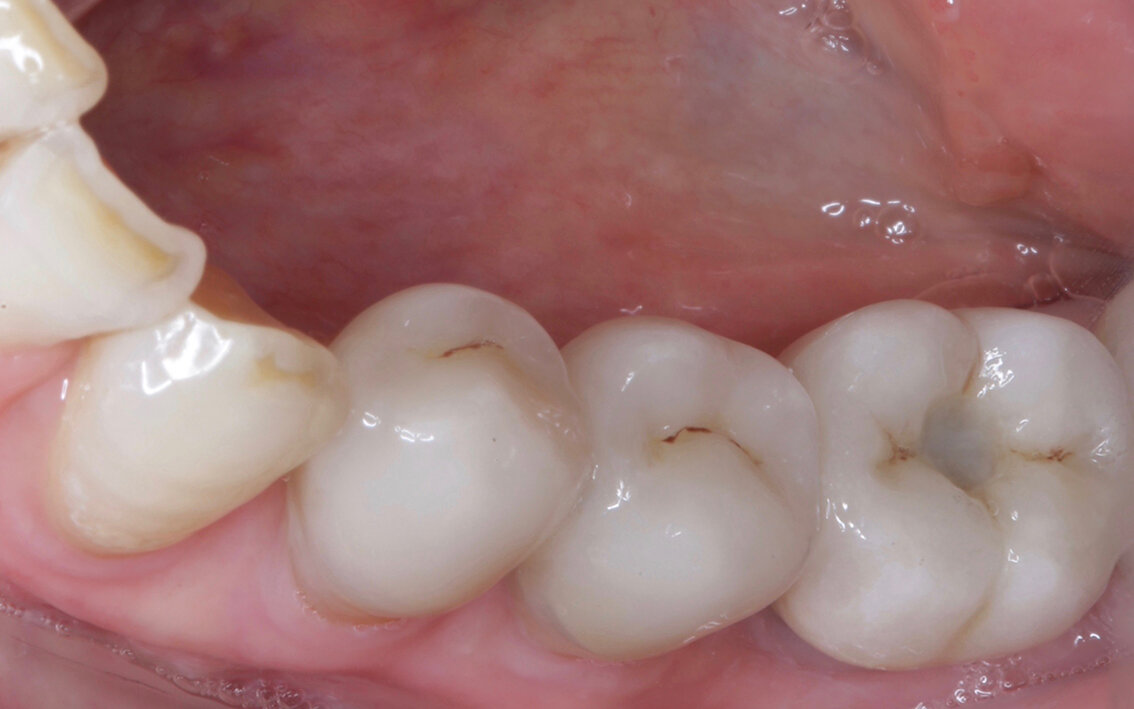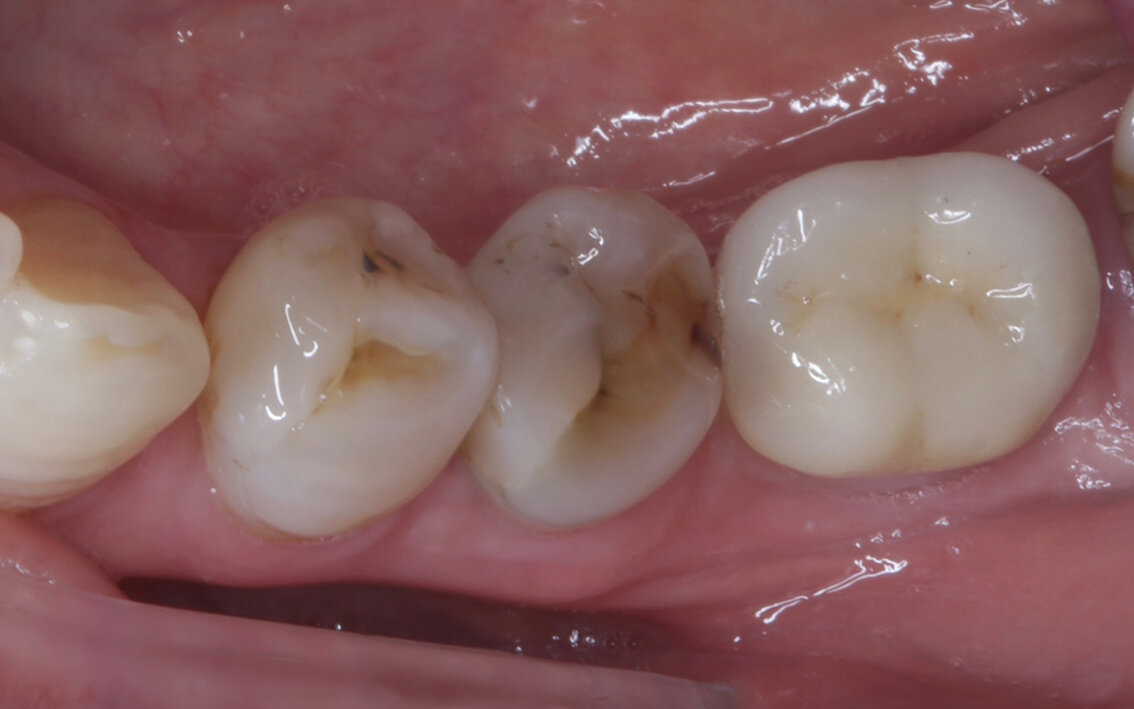Why might my dentist recommend a ceramic onlay?
Like dental crowns, an onlay covers the entire biting surface of the tooth and prevents fracture. Unlike a crown they do not cover all five surfaces of a tooth hence they do not have any sort of retentive form and are held in place entirely by dental adhesives.
Onlays are biologically more conservative as they require less tooth removal. Onlays are appropriate to restore teeth that require extensive restoration that still have an intact ring of dental enamel at the periphery. In the case of very broken down teeth a crown may be more appropriate.
An onlay aims to be as biologically conservative as possible hence much of the original tooth structure is still visible. This means onlays are typically able to only achieve a modest change in shape and colour
Is there a recognised speciality in onlays?
A Prosthodontist is a board-registered specialist in restorative treatment, including onlays, crowns, veneers and bridges. Any other stated qualification (i.e. cosmetic dentist, neuromuscular dentist, etc) is a self-dubbed title and just means the dentist has an interest in that procedure.
It would be reasonable to expect that a Prosthodontist would be more skilled in both the diagnostic and procedural aspects of porcelain onlays. They are also highly aware of the biological costs of such procedures and will discuss other suitable, conservative alternatives where appropriate.
How many appointments does a porcelain onlay take?
Treatment of a tooth with a porcelain onlay generally takes two visits that are three weeks apart:
At the first appointment, the tooth is shaped to receive an onlay. The old filling is removed and the remaining tooth structure is checkedfor an intact border of enamel, If this is not present then we prepare the tooth for a crown. The superficial 2mm of tooth is removed from the biting surface and the remaining tooth is smoothed into a confluent structure. Bevels and finish lines are placed to maximise dental adhesion to the peripheral enamel. An impression is taken and sent to the dental laboratory and a temporary onlay is inserted to prevent dental sensitivity.
At the second appointment the onlay is tried-in, adjusted and cemented.
There is generally a three-week space between the preparation and cementation appointments - this is the time it takes to get a premium lab to make a porcelain onlay that we would be comfortable to put our name to.
I have seen “onlays veneers” or “same-day onlays” advertised online - why should I avoid these? ⬇️
At Queensland Prosthodontics our focus is to produce the best onlays possible for our patients - that is use the best materials, techniques and dental technicians we can source. If sending Dental work overseas or using chair-side milling machines improved our quality we would do it! Unfortunately this is not the case and all these approaches do is increase the profit-margin for the treating clinician - not the quality for the patient!
Dental Laboratories that make “cheap onlays” often send their work to China (such as Southern Cross Dental Laboratory), use non-skilled labour or mill the veneers in the dental office using a CNC machine. Each of these cost-cutting measures compromises the longevity, biocompatibility and aesthetics of an onlay.
“Same Day onlays” are made in the dental surgery by a milling machine (i.e. Cerec, E4D, etc). These veneers are literally carved out of a solid block of ceramic that is one flat colour. These types of restorations only take one appointment and are cheaperas they eliminate the expense of sending work to a dental laboratory. There are a number of drawbacks to this treatment approach:
Same-day onlays tend not to fit as well which is a problem for gum inflammation, dental decay and tooth-sensitivity.
- They don’t look like natural teeth - the are milled out of a sold block of ceramic, hence they are one solid colour and tend to be quite opaque.
- Milled ceramic requires a minimum thicknesss that is thicker than a cast onlay, hence the tooth-reduction has to be more aggressive.
- Same-day onlays are weaker when compared to lab-made onlays - In the case of suitable ceramics such as lithium disilicate (Emax) there is evidence to suggest a traditional mould-and-cast approach produces a crown with superior mechanical properties when compared with a crown milled out of the same material.
All our onlays, veneers, crowns and bridges are hand-made by premium dental labs and there is a fair bit of skill that goes into each and every onlay. As such our dental technicians charge a premium for their time, skill and use of the best materials and this cost is reflected in our fees.
What about overseas dental work? 🔽
Having dental work done in developing-countries such as Thailand, Bali or India is obviously far less expensive than Australia. Generally it is impossible to talk a patient out of going down this path as they view dental treatment as a “commodity" as opposed to a “skill-based service”. They think they are getting “like-for-like” for a fraction of the cost - but this is far from the case. Many of these clinics have opulent waiting rooms and operatories which give the impression of quality however if we recall patients can only judge the quality of an experience, not the technical quality of the dental work they are receiving.
Firstly it is important to state that the only thing that is cheaper overseas is labour. The cost of high quality materials (i.e. gold, branded ceramics, etc) and main-brand dental components (i.e. Straumann, Nobel, Astra, etc) is standardised across the globe. So there is a baseline cost that cannot be avoided without using dodgy materials or counterfeit implant components. If the price of a procedure seems too good to be true, it probably is!It would be a falsity to say that Australia is the only place where quality dental care exists. However if you have a crown done in the town where you live the clinician is medico-legally accountable for their work. They will continue to see it year after year. If it fails you are likely to go back to them.
In the case of travel-dentistry no-one is accountable. International crowns, bridges and implants only have to last the duration of your stay in their country. In the event of a dental emergency it is unlikely you will have the time or finances to drop everything and fly back to the country where you were treated to have the dental work rectified. In the event of negligence it would be a near impractical to take action against an overseas clinic with a foreign legal system. Clinics that hunt for dental tourism know this and exploit these loopholes.
As I said before - it is a near impossibility to talk a patient out of going down the path of overseas dentistry if this is what they have set their mind to. And whilst there may be success stories I am unaware of them.In a nutshell it is all about risk - crowns, bridges and implants are irreversible, invasive procedures that require careful monitoring and maintenance for the duration of their lifespan. In the case of overseas dental work no-one is accountable and in the event of failure you will wind up in a worse situation than when you started. Any initial savings would pale in comparison to what it may cost to fix up such work.
Onlays Gallery





